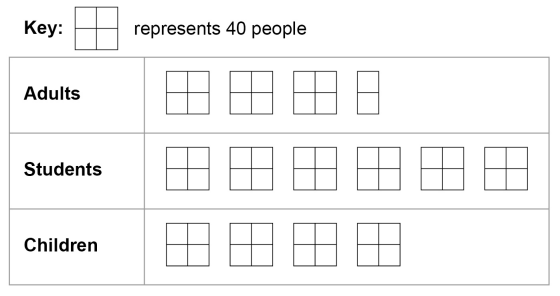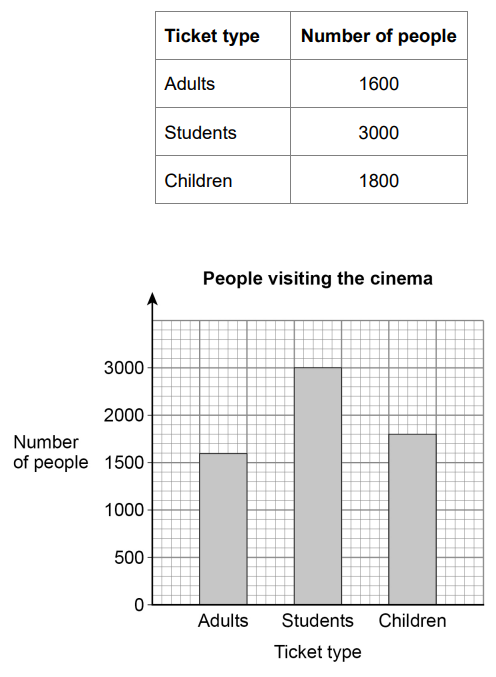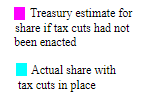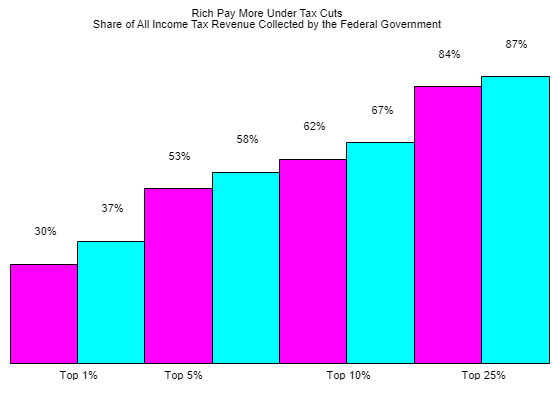(11.) ACT A construction company builds $3$ different models of houses (A, B, and C).
They order all the bathtubs, shower stalls, and sinks for the houses from a certain manufacturer.
Each model of house contains different numbers of these bathroom fixtures.
The tables below give the number of each kind of these fixtures required for each model and the cost to the company, in dollars, or each type of fixture.
The company plans to build $3$ A's, $4$ B's, and $6$ C's.
What will be the cost to the company of exactly enough of these bathroom fixtures to put the required number in all of these houses?
$ F.\:\: \$1,940 \\[3ex] G.\:\: \$2,070 \\[3ex] H.\:\: \$8,940 \\[3ex] J.\:\: \$9,180 \\[3ex] K.\:\: \$10,450 \\[3ex] $
Model A requires $1$ bathtub, no shower stall, and $1$ sink
Model B requires $1$ bathtub, $1$ shower stall, and $2$ sinks
Model C requires $2$ bathtubs, $1$ shower stall, and $4$ sinks
A bathtub costs $\$250$
A shower stall costs $\$150$
A sink costs $\$120$
$ Cost\:\:of\:\:Model\:\:A \\[3ex] = 1(250) + 0(150) + 1(120) \\[3ex] = 250 + 0 + 120 \\[3ex] = \$370 \\[3ex] Cost\:\:of\:\:3\:\:A's \\[3ex] = 3(370) \\[3ex] = \$1110 \\[3ex] Cost\:\:of\:\:Model\:\:B \\[3ex] = 1(250) + 1(150) + 2(120) \\[3ex] = 250 + 150 + 240 \\[3ex] = \$640 \\[3ex] Cost\:\:of\:\:4\:\:B's \\[3ex] = 4(640) \\[3ex] = \$2560 \\[3ex] Cost\:\:of\:\:Model\:\:C \\[3ex] = 2(250) + 1(150) + 4(120) \\[3ex] = 500 + 150 + 480 \\[3ex] = \$1130 \\[3ex] Cost\:\:of\:\:6\:\:C's \\[3ex] = 6(1130) \\[3ex] = \$6780 \\[3ex] Total\:\:Cost \\[3ex] = 1110 + 2560 + 6780 \\[3ex] = \$10,450 $
They order all the bathtubs, shower stalls, and sinks for the houses from a certain manufacturer.
Each model of house contains different numbers of these bathroom fixtures.
The tables below give the number of each kind of these fixtures required for each model and the cost to the company, in dollars, or each type of fixture.
| Fixture | Model | ||
|---|---|---|---|
| A | B | C | |
|
Bathtubs Shower stalls Sinks |
$1$ $0$ $1$ |
$1$ $1$ $2$ |
$2$ $1$ $4$ |
| Fixture | Cost |
|---|---|
|
Bathtubs Shower stalls Sinks |
$\$250$ $\$150$ $\$120$ |
The company plans to build $3$ A's, $4$ B's, and $6$ C's.
What will be the cost to the company of exactly enough of these bathroom fixtures to put the required number in all of these houses?
$ F.\:\: \$1,940 \\[3ex] G.\:\: \$2,070 \\[3ex] H.\:\: \$8,940 \\[3ex] J.\:\: \$9,180 \\[3ex] K.\:\: \$10,450 \\[3ex] $
Model A requires $1$ bathtub, no shower stall, and $1$ sink
Model B requires $1$ bathtub, $1$ shower stall, and $2$ sinks
Model C requires $2$ bathtubs, $1$ shower stall, and $4$ sinks
A bathtub costs $\$250$
A shower stall costs $\$150$
A sink costs $\$120$
$ Cost\:\:of\:\:Model\:\:A \\[3ex] = 1(250) + 0(150) + 1(120) \\[3ex] = 250 + 0 + 120 \\[3ex] = \$370 \\[3ex] Cost\:\:of\:\:3\:\:A's \\[3ex] = 3(370) \\[3ex] = \$1110 \\[3ex] Cost\:\:of\:\:Model\:\:B \\[3ex] = 1(250) + 1(150) + 2(120) \\[3ex] = 250 + 150 + 240 \\[3ex] = \$640 \\[3ex] Cost\:\:of\:\:4\:\:B's \\[3ex] = 4(640) \\[3ex] = \$2560 \\[3ex] Cost\:\:of\:\:Model\:\:C \\[3ex] = 2(250) + 1(150) + 4(120) \\[3ex] = 500 + 150 + 480 \\[3ex] = \$1130 \\[3ex] Cost\:\:of\:\:6\:\:C's \\[3ex] = 6(1130) \\[3ex] = \$6780 \\[3ex] Total\:\:Cost \\[3ex] = 1110 + 2560 + 6780 \\[3ex] = \$10,450 $
(12.) CSEC The diagram below, not drawn to scale, shows two jars of peanut butter of the
same brand.
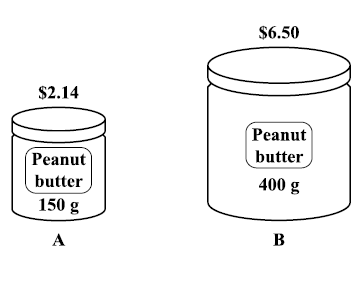
Which of the jars shown above is the BETTER buy?
Show ALL working to support your answer.
We can do this question in at least two ways...Without a Calculator and With a Calculator.
Use any method you prefer.
First Method: Proportional Reasoning Method
This method uses a calculator.
To determine the better buy, we need to calculate the cost of a unit gram (cost of 1 gram) of peanut butter for each jar.
The jar that has the least cost for a unit gram of peanut butter is the better buy.
Let the unit cost of peanut butter in Jar A = $A$
Let the unit cost of peanut butter in Jar B = $B$
$ \dfrac{A}{1} = \dfrac{2.14}{150} \\[5ex] A = 0.0142666667 \\[3ex] A \approx \$0.01 \\[3ex] $
$ \dfrac{B}{1} = \dfrac{6.5}{400} \\[5ex] B = 0.01625 \\[3ex] B \approx \$0.02 \\[3ex] $ Jar $A$ costs about a cent for a unit gram of peanut butter
Jar $B$ costs about two cents for a unit gram of peanut butter
Jar $A$ is the better buy because it costs less for a unit gram of peanut butter.
Second Method: Quantitative Reasoning Method
This method does not need a calculator.
$ \underline{Jar\:A} \\[3ex] 150\:g\:\:for\:\:\$2.14 \\[3ex] 2(150)\:\:g\:\:for\:\:2(2.14) \rightarrow 300\:g\:\:for\:\:\$4.28 \\[3ex] 3(150)\:\:g\:\:for\:\:3(2.14) \rightarrow 450\:g\:\:for\:\:\$6.42 \\[3ex] 3\:\:jars\:\:of\:\:A = 450g\:\:for\:\:\$6.42 \\[3ex] \underline{Jar\:\:B} \\[3ex] 400\:g\:\:for\:\:\$6.50 \\[3ex] Compare: \\[3ex] 450\:g\:\:for\:\:\$6.42\:\:versus\:\:400\:g\:\:for\:\:\$6.50 \\[3ex] 450\:g\:\:for\:\:\$6.42\:\:much\:\:better...get\:\:more\:\:for\:\:less \\[3ex] \therefore Jar\:A\:\:is\:\:the\:\:better\:\:buy $

Which of the jars shown above is the BETTER buy?
Show ALL working to support your answer.
We can do this question in at least two ways...Without a Calculator and With a Calculator.
Use any method you prefer.
First Method: Proportional Reasoning Method
This method uses a calculator.
To determine the better buy, we need to calculate the cost of a unit gram (cost of 1 gram) of peanut butter for each jar.
The jar that has the least cost for a unit gram of peanut butter is the better buy.
Let the unit cost of peanut butter in Jar A = $A$
Let the unit cost of peanut butter in Jar B = $B$
| $Amount (g)$ | $Cost (\$)$ |
|---|---|
| $150$ | $2.14$ |
| $1$ | $A$ |
$ \dfrac{A}{1} = \dfrac{2.14}{150} \\[5ex] A = 0.0142666667 \\[3ex] A \approx \$0.01 \\[3ex] $
| $Amount (g)$ | $Cost (\$)$ |
|---|---|
| $400$ | $6.50$ |
| $1$ | $B$ |
$ \dfrac{B}{1} = \dfrac{6.5}{400} \\[5ex] B = 0.01625 \\[3ex] B \approx \$0.02 \\[3ex] $ Jar $A$ costs about a cent for a unit gram of peanut butter
Jar $B$ costs about two cents for a unit gram of peanut butter
Jar $A$ is the better buy because it costs less for a unit gram of peanut butter.
Second Method: Quantitative Reasoning Method
This method does not need a calculator.
$ \underline{Jar\:A} \\[3ex] 150\:g\:\:for\:\:\$2.14 \\[3ex] 2(150)\:\:g\:\:for\:\:2(2.14) \rightarrow 300\:g\:\:for\:\:\$4.28 \\[3ex] 3(150)\:\:g\:\:for\:\:3(2.14) \rightarrow 450\:g\:\:for\:\:\$6.42 \\[3ex] 3\:\:jars\:\:of\:\:A = 450g\:\:for\:\:\$6.42 \\[3ex] \underline{Jar\:\:B} \\[3ex] 400\:g\:\:for\:\:\$6.50 \\[3ex] Compare: \\[3ex] 450\:g\:\:for\:\:\$6.42\:\:versus\:\:400\:g\:\:for\:\:\$6.50 \\[3ex] 450\:g\:\:for\:\:\$6.42\:\:much\:\:better...get\:\:more\:\:for\:\:less \\[3ex] \therefore Jar\:A\:\:is\:\:the\:\:better\:\:buy $

